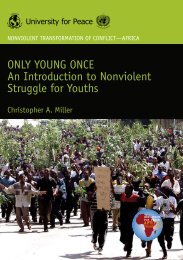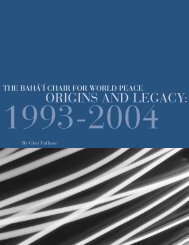IntroductionACCORDING to the 1993 population census eighty-six percent <strong>of</strong> the DarfurPopulation lived <strong>in</strong> the rural are<strong>as</strong>, with modes <strong>of</strong> liv<strong>in</strong>g be<strong>in</strong>g either traditionalagriculture or livestock rear<strong>in</strong>g. Competition between farmers andherders is <strong>in</strong>cre<strong>as</strong><strong>in</strong>gly becom<strong>in</strong>g acute, lead<strong>in</strong>g on many occ<strong>as</strong>ions to violent <strong>conflict</strong>s.Two factors have been responsible for aggravat<strong>in</strong>g the <strong>conflict</strong> situation <strong>in</strong>the region. One <strong>of</strong> them is lack <strong>of</strong> development, which h<strong>as</strong> kept the region at thestage <strong>of</strong> traditional or semi-traditional society. In such a society, <strong>in</strong>dividuals andgroups rely on communal solidarity for the provision <strong>of</strong> material needs and protection(see Palmer 1980).The government <strong>in</strong>stitutions that cater to the protection <strong>of</strong> people’s life andproperty either do not exist or are <strong>in</strong>adequate to do the job. Identity groups tend torely on their communal <strong>in</strong>stitutions for sustenance and wellbe<strong>in</strong>g. The image <strong>of</strong> the‘warrior man’ develops spontaneously to protect one’s community or to attack othercommunities. On the other hand, women are <strong>as</strong>signed the role <strong>of</strong> arbiters <strong>of</strong> man’sconduct. Among the Arab nomadic groups, the Hakkama, which means literally thearbiter <strong>of</strong> conduct, is a s<strong>in</strong>ger who composes songs encourag<strong>in</strong>g her people to go towar and fight to the death (see Mohamed 2004). The relationship among local communitiesh<strong>as</strong> mostly been characterized by hostility, lack <strong>of</strong> trust and predispositionto go to war aga<strong>in</strong>st one another.The other factor, lead<strong>in</strong>g to <strong>in</strong>ter-group <strong>conflict</strong>s, is p<strong>as</strong>toral nomadism <strong>as</strong> amode <strong>of</strong> liv<strong>in</strong>g for a sizable number <strong>of</strong> the rural population. Not only would the livestocktresp<strong>as</strong>s onto farmlands, but also the nomadic people themselves are predisposedto engage <strong>in</strong> raid<strong>in</strong>g and fight<strong>in</strong>g with other communities, particularly withsettled farmers. In his Muqaddima (Introduction) Ibn Khaldun describes very vividlythe attitude and behaviour patterns <strong>of</strong> the nomadic groups he personally observed<strong>in</strong> North Africa at the time <strong>of</strong> his writ<strong>in</strong>g (see Rosenthal 1958). Ibn Khaldun goesto the extent <strong>of</strong> attribut<strong>in</strong>g the rise and fall <strong>of</strong> leaderships and k<strong>in</strong>gdoms <strong>in</strong> NorthAfrica to wars <strong>in</strong> which the nomads were the ma<strong>in</strong> actors.In fact, it is not only the Arab nomads who are predisposed to go to war. Manyanalysts would regard nomadism, per se, <strong>as</strong> related to raid<strong>in</strong>g and violent behaviour.Many <strong>of</strong> them would make the po<strong>in</strong>t that even the ‘Great Wall <strong>of</strong> Ch<strong>in</strong>a’ w<strong>as</strong> built tostop the nomads from attack<strong>in</strong>g the settled farmers.In the Sudan, the nomadic segments <strong>of</strong> the population are to be found <strong>in</strong> severalplaces, although <strong>in</strong>cre<strong>as</strong><strong>in</strong>gly they are becom<strong>in</strong>g settled farmers. Particularly importantfor our discussion are the nomadic groups that are to be found <strong>in</strong> two ecologicalzones: the first zone is the semi-desert that extends all the way from the River Nile<strong>in</strong> the Sudan to Ennedi Mounta<strong>in</strong>s <strong>in</strong> the present day Chad republic. This belt h<strong>as</strong>been and still is occupied by camel nomads <strong>of</strong> different groups <strong>of</strong> Arabs and non-Ar-68
abs. In the p<strong>as</strong>t they had been <strong>in</strong>volved <strong>in</strong> raid<strong>in</strong>g and counter-raid<strong>in</strong>g aga<strong>in</strong>st oneanother and aga<strong>in</strong>st settled farmers (see Beck 1996). It took the colonial governmentconsiderable time and effort to control them and prevent them from attack<strong>in</strong>gone another or attack<strong>in</strong>g the settled farmers (see Beck 1996).The other ecological zone is the one extend<strong>in</strong>g from the White Nile <strong>in</strong> the Sudanto Lake Chad. This belt is a rich savanna, suited for rais<strong>in</strong>g cattle and is occupied bythe Baqqara, i.e. the cattle-own<strong>in</strong>g people, who are mostly Arabs. Observers makethe po<strong>in</strong>t that nomads <strong>in</strong> this belt are <strong>in</strong>cre<strong>as</strong><strong>in</strong>gly becom<strong>in</strong>g settled farmers andonly a small number <strong>of</strong> them cont<strong>in</strong>ue to keep herd<strong>in</strong>g <strong>as</strong> a means <strong>of</strong> livelihood (seeBraukamper 2000). Darfur region h<strong>as</strong> long strips <strong>of</strong> the two ecological zones, andhence, a sizable number <strong>of</strong> its population is still nomadic.B<strong>as</strong>har (2003) found that out <strong>of</strong> the thirty-n<strong>in</strong>e major tribal <strong>conflict</strong>s that tookplace <strong>in</strong> Darfur dur<strong>in</strong>g the period 1923-2003, the nomadic groups were <strong>in</strong>volved <strong>in</strong>twenty-n<strong>in</strong>e <strong>of</strong> them, a fact which h<strong>as</strong> been confirmed by Mukhtar (<strong>in</strong> Mohamed andWadi 1998) and Takana (<strong>in</strong> Mohamed and Wadi, 1998). Violent tribal <strong>conflict</strong>s <strong>in</strong> theDarfur region, therefore, cannot be adequately expla<strong>in</strong>ed without reference be<strong>in</strong>gmade to p<strong>as</strong>toral nomadism <strong>as</strong> a mode <strong>of</strong> liv<strong>in</strong>g <strong>in</strong> the region.However, be<strong>cause</strong> Darfur is now a war-torn region, one should not jump to theconclusion that it h<strong>as</strong> always been like that and that it had no heritage <strong>of</strong> peacefulcoexistence among its different groups. In fact, the region had enjoyed anexceptionally peaceful coexistence, for at le<strong>as</strong>t the period follow<strong>in</strong>g its annexationto the rest <strong>of</strong> Sudan <strong>in</strong> 1916 and up to 1956, the end <strong>of</strong> the foreign rule. Prior tothat time and follow<strong>in</strong>g it the region h<strong>as</strong> been marred by all types <strong>of</strong> ethnic andtribal <strong>conflict</strong>. The colonial government <strong>in</strong> Darfur (1916-1956) needed to arrangefor only two conferences to resolve <strong>conflict</strong>s. The first w<strong>as</strong> <strong>in</strong> 1924 between theRizayqat cattle nomads and the D<strong>in</strong>ka, their neighbours to the south. The second,<strong>in</strong> 1932, w<strong>as</strong> between the camel nomads <strong>of</strong> northern Kord<strong>of</strong>an, the Kababish andthe Kawahla. and their neighbours <strong>in</strong> northern Darfur, the Zayyadiyya, Berti andMeidob. The conference w<strong>as</strong> held <strong>in</strong> Umm Goza<strong>in</strong>, a border area between the twoprov<strong>in</strong>ces (see B<strong>as</strong>har 2003).By contr<strong>as</strong>t, follow<strong>in</strong>g the declaration <strong>of</strong> <strong>in</strong>dependence <strong>in</strong> 1956, and up to now,<strong>in</strong>ter-group <strong>conflict</strong>s and subsequent reconciliation conferences to resolve themhave become the rule rather than the exception, result<strong>in</strong>g <strong>in</strong> an average <strong>of</strong> 1.5conferences per year. In fact, 6 reconciliation conferences were held <strong>in</strong> 1991 alone.No attempt will be made here, however, to expla<strong>in</strong> these strik<strong>in</strong>g <strong>in</strong>cre<strong>as</strong>es <strong>in</strong> thefrequency <strong>of</strong> <strong>conflict</strong>s and reconciliation conferences to resolve them. Rather Iwould refer the reader to Mohamed (2002, 2004).One ma<strong>in</strong> factor needs to be mentioned though: the philosophy <strong>of</strong> governanceh<strong>as</strong> much to do with the phenomenon. Notwithstand<strong>in</strong>g the fact that the British,who ruled the Sudan (1898-1956) were colonizers <strong>in</strong> the first place, and they were69
- Page 1:
ENVIRONMENTAL DEGRADATIONAS A CAUSE
- Page 4 and 5:
Cover Photo:AU forces patrol Darfur
- Page 7 and 8:
PREFACEThese essays were originally
- Page 9 and 10:
AcknowledgementsThe conference was
- Page 11 and 12:
Executive SummaryByMary E. King and
- Page 13 and 14:
the theme of the conference, outlin
- Page 15 and 16:
• The question of warrior culture
- Page 17 and 18: Deryke Belshaw, University of East
- Page 19 and 20: area in West Darfur of 1.5m feddans
- Page 21 and 22: on the interaction between conflict
- Page 23 and 24: Conflict In DarfurHistorical andCon
- Page 25 and 26: distributive centre and where the r
- Page 28 and 29: sues quite separate. Evidence for t
- Page 30 and 31: FOOTNOTES1It is not my purpose here
- Page 32 and 33: 20On other emerging ethnically-base
- Page 34 and 35: IntroductionTHE Greater Darfur regi
- Page 36 and 37: 2. Agriculture (Farming)Crop farmin
- Page 38 and 39: Secondly, the demand for mutton and
- Page 40 and 41: groundnut and sesame as sources of
- Page 42 and 43: The situation of drinking water in
- Page 44 and 45: ReferencesConference, Meleet, North
- Page 46 and 47: IntroductionTHE residents of the Um
- Page 48 and 49: Phase Two:This phase was a monitori
- Page 50 and 51: zone southward — and to use these
- Page 52 and 53: • Some water points in places lik
- Page 54 and 55: This study and the seminar organize
- Page 57 and 58: Land Tenure,Land Use andConflicts i
- Page 59 and 60: tain innovations called hakura (pl.
- Page 61 and 62: mands for food production. All thes
- Page 63 and 64: Hashab Tenure SystemHashab ownershi
- Page 65 and 66: co-exist at the local level where e
- Page 67: IndigenousInstitutions andPractices
- Page 71 and 72: Sufi OrderSufi orders are religious
- Page 73 and 74: Native Administration, i.e. Tribal
- Page 75 and 76: Rizayqat homeland is at the extreme
- Page 77 and 78: esearchers and statesmen. A bigger
- Page 79: ReferencesBakheit, Jaafar M.Ali. 19
- Page 82 and 83: IntroductionWHILE in the Sudan prot
- Page 84 and 85: ReferencesHarir, S. 1993. ‘Arab B
- Page 86 and 87: IntroductionTHE Darfur Region lies
- Page 88 and 89: Table (1)Water program for Darfur 2
- Page 90 and 91: anging from 150mm the north and 450
- Page 92 and 93: ReferencesIbrahim, Abdel Rahman Abb
- Page 94 and 95: CONCLUSIONTHE collection of papers
- Page 96 and 97: GLOSSARYAjawidArdaBaqqaraDarDukhnFa
- Page 99 and 100: A Darfur Timeline99
- Page 101 and 102: 1898 On the eve of the battle of Om
- Page 103 and 104: Bibliography103
- Page 105 and 106: El Mahdi S. Mohamed. 1979. Introduc
- Page 107 and 108: Tothill, J.D. 1948. Agriculture in
- Page 109 and 110: Biographical Sketch: Rex Sean O’F
- Page 111 and 112: 111











